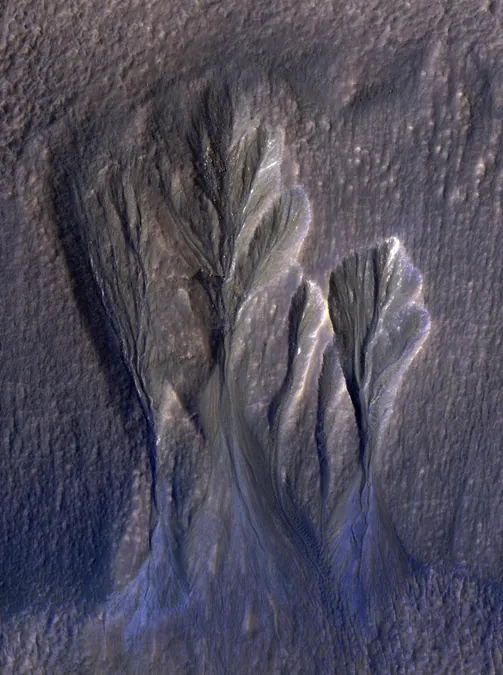
Could Life Be Thriving Beneath the Martian Ice? Discover the Fascinating Possibilities!
2024-11-13
Author: Wei Ling
Introduction
Mars has captivated human imagination for centuries, once inspiring fantasies of sophisticated civilizations. However, space exploration has revealed a far more desolate and unwelcoming landscape. Beneath the planet’s barren surface lies a layer of water ice just a few meters thick. NASA's recent study raises tantalizing prospects: could sunlight be penetrating this icy crust, enabling photosynthesis in the meltwater below?
The Journey of Exploration
Beginning in the 1960s with Soviet missions and NASA's Mariner probes, the quest to explore Mars has yielded numerous milestones. The Viking landers of 1976 were pioneering missions designed to test Martian soil for signs of life. This was followed by the Mars Pathfinder, which successfully deployed the Sojourner rover, and later, the Spirit and Opportunity rovers transformed our understanding of the planet's potential habitability. The Curiosity and Perseverance rovers—alongside China's Tianwen-1—have continued this exploration, focusing particularly on identifying water sources and analyzing the Martian climate and geology.
The Question of Life
Despite extensive research, no definitive evidence of life has been discovered on Mars. Yet, the question remains; Mars is often regarded as the most promising candidate for hosting primitive life due to its past presence of liquid water. Geological features like ancient riverbeds and mineral deposits suggest that Mars was once a much warmer and wetter world, possibly harboring conditions conducive to life. Moreover, organic molecules deciphered by rovers further fuel the excitement in the scientific community as researchers tirelessly search for microbial life—both past and present.
Recent Insights from NASA
The latest research from a dedicated team at NASA has provided fresh insights using computer modeling techniques. Their findings suggest that sunlight may indeed penetrate through Martian water ice layers, potentially allowing for photosynthesis to occur in meltwater pools. There are two main types of ice present on Mars: frozen water and frozen carbon dioxide. The study primarily examined water ice, primarily formed from snow during a Martian ice age millions of years ago.
Role of Dust in Photosynthesis
Based on the research, dust particles that accumulate on the ice's surface might play a critical role in facilitating photosynthesis. These dark dust particles can absorb sunlight, causing them to heat up more than the surrounding ice, leading to melting and creating shallow water pools beneath the ice. While some scientists argue that surface ice remains frozen due to the thin Martian atmosphere—a process that could cause ice to sublimate directly into gas—this phenomenon does not apply to the deeper ice layers.
Comparison to Earth
This mechanism has a striking parallel on Earth, where similar conditions allow dust to melt ice and create pockets of liquid water, fostering ecosystems that harbor simplistic life forms. The published study in *Nature Communications Earth & Environment* suggests that such processes could enable light to penetrate depths of up to 3 meters under the ice, thus creating conditions suitable for photosynthesis. The subsurface pools would be insulated from evaporation by the protective icy layer above, which also offers a shield from harmful radiation—an encouraging prospect for the existence of simple life forms.
Potential Habitable Locations
The findings indicate that locations with the most potential for these habitable environments could be found in Martian tropics, specifically between 30 and 60 degrees latitude in both hemispheres. As we unlock the secrets of Mars' icy depths, the possibility of encountering life as we know it—or perhaps, life unlike anything we've ever seen—remains a thrilling frontier in astrobiology. Stay tuned, because our journey to uncover the mysteries of Mars is only just beginning!



 Brasil (PT)
Brasil (PT)
 Canada (EN)
Canada (EN)
 Chile (ES)
Chile (ES)
 España (ES)
España (ES)
 France (FR)
France (FR)
 Hong Kong (EN)
Hong Kong (EN)
 Italia (IT)
Italia (IT)
 日本 (JA)
日本 (JA)
 Magyarország (HU)
Magyarország (HU)
 Norge (NO)
Norge (NO)
 Polska (PL)
Polska (PL)
 Schweiz (DE)
Schweiz (DE)
 Singapore (EN)
Singapore (EN)
 Sverige (SV)
Sverige (SV)
 Suomi (FI)
Suomi (FI)
 Türkiye (TR)
Türkiye (TR)